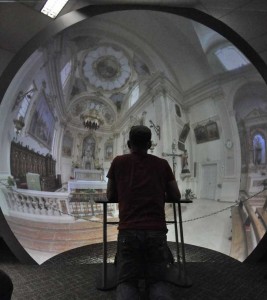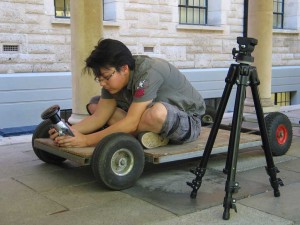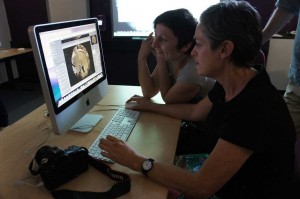ANAT’s Dome Lab 2010 was held in Perth, Western Australia from 1 – 5 November 2010 and brought the world’s leading fulldome experts together with their local counterparts to learn about and experiment with filmmaking for domed screens. As an intern at ANAT, I had the opportunity to document the workshop. Together with twenty-three talented participants and six tutors, I made my way to Perth to learn all the ins and outs of fulldome and other frameless screens.

Viewing an image in the iDome. Photo: Eva Sprenkelder
DomeLab2010 started with a screening of tutors’ work in Perth’s Horizon Planetarium, which has a large 18m domed screen. The tutors introduced themselves and showed footage from their past and present dome productions. The huge range of different possibilities and approaches for using the dome rapidly became clear.
The tutors all had their own areas of experience and knowledge and were all really passionate about fulldome content. Ben Shedd talked about the power of frameless spaces and the principles of immersive design. Warik Lawrence gave an introductory presentation about Production Design for Fulldome. Hue Walker explained how to organise dome productions, and Peter Morse and Jonathan Strawn, supported by various examples their work including stills, video and live video, gave a good overview of the different approaches that can be used for the dome. After the first day, we were all overloaded with information!
On the second day, Paul Bourke introduced the LadyBug3. We had all noticed this camera on the first day, and I was really excited about it: a device that included six cameras for 360-degree footage. Paul explained how to edit dome footage using LadybugCapPro and After Effects, which was very useful because four days of shooting with fish eye lenses and editing the resulting footage were coming up!

Setting up the camera. Photo: Eva Sprenkelder
The participants did several shooting exercises in teams: experiments and explorations with timing, various angles, environments and close-ups. After the first session, it was already clear that there was a high level of experience, creativity and skill in the teams. Everybody was very approachable and keen to help each other. This positive group dynamic continued after work, with participants, tutors and presenters meeting up for drinks and walks through beautiful Perth.
At the end of every day we viewed the footage from the filming exercises. The labs facilities were great – we had access to three domes: the iDome (a vertical dome, 3m domed screen), an inflatable dome (a horizontal dome with a 5m domed screen) and a GeoDome (also an inflatable dome, but with a 6m internal screen width). It was interesting to see the different focal points in the different domes, how much the fish eye lenses captured, and how this footage filled up the domes. I was really surprised by the high quality of the final screenings at the end of the week, and enjoyed hearing the participants’ experiences and discoveries in their week’s work on the wrap BBQ. More information about the editing process for dome content would have been useful, so those participants without editing experience could have been more helpful during post-production sessions – although a second week of workshops would have be necessary to achieve this goal.

Editing footage. Photo: Eva Sprenkelder
After attending DomeLab, I can see many applications for the dome for data visualisation, storytelling and teaching. I think the dome really works for specific subjects and production formats such as documentaries or short experimental films. I met many inspiring people and enjoyed the opportunity to have access to high-tech equipment and the well-chosen, photogenic location. Thanks to the participants, organisers and tutors to make this informative week possible.
Eva Sprenkelder
Eva Sprenkelder is a student Arts and Media Management at Utrecht School of the Arts and is currently an intern at ANAT.
Read More
http://domelab2010.anat.org.au
See More
Watch More
Ben Shedd on the principles of immersive design
Warik Lawrance on production design for fulldome
 This work is licensed under a Creative Commons Attribution-NonCommercial-ShareAlike 3.0 Australia.
This work is licensed under a Creative Commons Attribution-NonCommercial-ShareAlike 3.0 Australia.







[...] And ANAT Documenter Eva Sprenkelders blog on the event here: https://filter.anat.org.au/issue-75/domelab-2010/ [...]